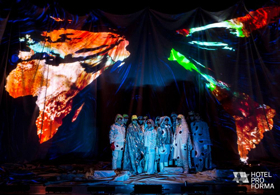Review: Kennedy Center's NEOARCTIC a Feast for the Senses

Although the Performance Art movement has been around for decades, it is still news when it comes to town. The idea of a heady mix of diverse arts-plastic, visual, musical, theatrical-has always been with us, but usually they are blended in such a way as to present a homogeneous whole.
Performance artists, on the other hand, prefer breaking the spectacle into discreet units, so that the audience is aware of the separateness of each contribution. This can dilute any intended effect, but it can liberate the mind of the viewer/listener in wonderful ways.
Kirsten Dehlholm, founder of the Danish production house Hotel Pro Forma, has brought her production of NeoArctic to the Kennedy Center for just a few nights. An intensely collaborative piece, NeoArctic features a barrage of images, light, costume, discreet movement and intensely beautiful chant from the Latvian Radio Choir, to create an evening that is as evocative as it is new. Each element has its gesture, each element attracts and distracts, and although the senses sometimes tip into overload it is an experience that reminds us the value of everything from air, to dust, to mud.
The piece is rooted in the fact that the Arctic is no longer a vast, impregnable ice cap, but is now an ocean. Ships easily sail the famous Northwest Passage, and prospectors are making plans to exploit oil that was inaccessible until our new age-which has already been given a name, Anthropocene, to reflect our role in the creation of new climate patterns.
The idea of a spectacle dedicated to global warming might seem slight, with all the charm of a 3rd grade play featuring your neighbor's daughter in a polar bear suit; but Dehlholm's careful work, rooted in both the science of climate change and the raw emotions of a natural world in flux, aims high and generally hits its mark.
The setting, by Anne Mette Fisker Langkjer, is deceptively simple at first; broad white sheets hung upstage, with rumpled sheets masking footlights across the floor. But once the piece begins, the sheets form a projection screen where video designs flood in-for each of the 12 chants. As the sheets begin to falter and bob, we are reminded of the massive ice cap's melting, and projections of ice chunks, floating, speak to the destruction of one of the most important temperature-moderators we have.
The ensemble, members of the Latvian Radio Choir, enter in a fantastical array of costumes designed by Pakistani-German artist Wali Mohammed Barrech, which are woven with reflective tissues enabling the singers to glitter and glow. By the end of the performance they wear modified snow gear and become sites of projections themselves, with beautiful images of microscopic and embryonic life, all under threat.
The melodies vary wildly from Medieval-style plainchant to modern tone clusters of astonishing complexity and beauty, made all the more haunting by lyrics from Icelandic writer Sigurjón Birgir Sigurðsson, also known as Sjon. Each poem is dedicated to one of three themes - Grain, Vapor and Ray - and in sparse, often repetitive language speaks to how precious even the most mundane particles of our world can be.
The song cycle's music was created by two composers, England's Andy Stott and Latvian Krists Auznieks (who, as our incredible luck would have it, currently lives in New York!). Director Dehlholm asked Stott and Auznieks to work separately, on 6 poems each, with a resulting variation in styles that can seem jolting and alienating for those whose concept of classical music is limited to the pathetic, centuries-old pablum of WETA 90.9. Stott's work shows clear signs of influence from the Techno and House music scenes, with more than one moment of homage to Brian Eno's experiments in ambient sound. Auznieks's music is more traditionally focused, and his contributions as a result will sound more familiar to denizens of the Kennedy Center concert hall.
Another innovation here is the use of voice-generated electric sound, which created haunting reverberations and enabled the 12-person choir to interact and commingle with the sounds of their own voices, live. For those accustomed to the traditional static limitations of artificial sound, in which mankind confronts the boombox and loses, it is inspiring to see the technology finally put to its best use, under the careful musical direction of Kaspars Putninš.
A unique experience like this is rare--and because it is rare, I have one big suggestion for the curators of the Kennedy Center's World Stages season: please have a pre-show talk, to acclimate traditional local audiences to the marvels they are about experience. A number of audience members, bewildered by the spectacle of NeoArctic, walked out, which represents a tremendous missed opportunity. Post-show talks are fine; if you are hosting a traditional performance nobody needs any preview. But when you are bringing in something this innovative, Kennedy Center audiences deserve an opportunity to explore new things by way of a brief tour of the glories to come.
Production Photo: The Latvian Radio Choir in NeoArctic. Photo courtesy of the artists.
Running Time: approximately 90 minutes with no intermission.
Neoarctic is part of the World Stages 2018-2019 season at the Kennedy Center.
For tickets, call 202-467-4600 or visit: http://www.kennedy-center.org/
Reader Reviews
Videos

